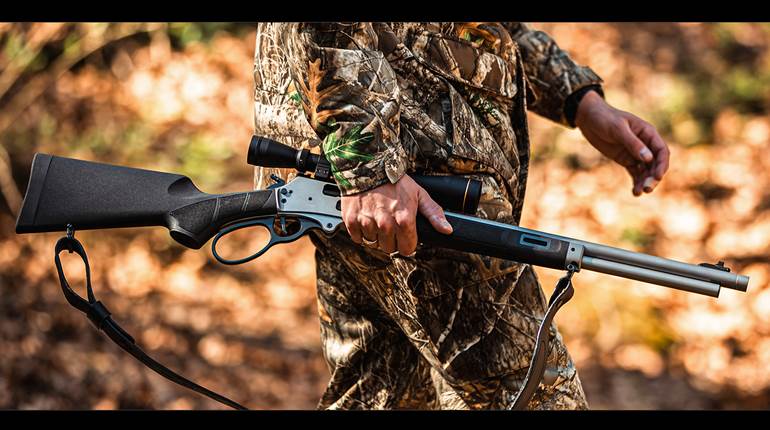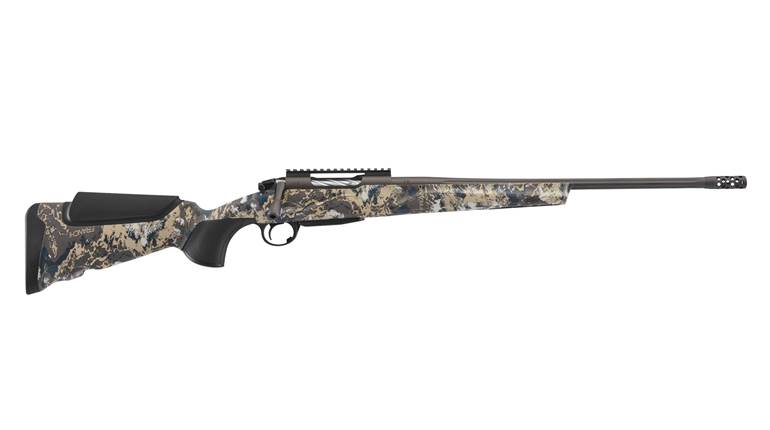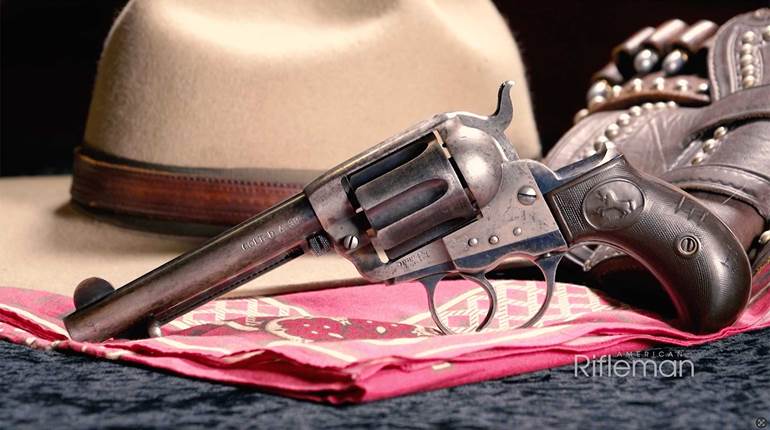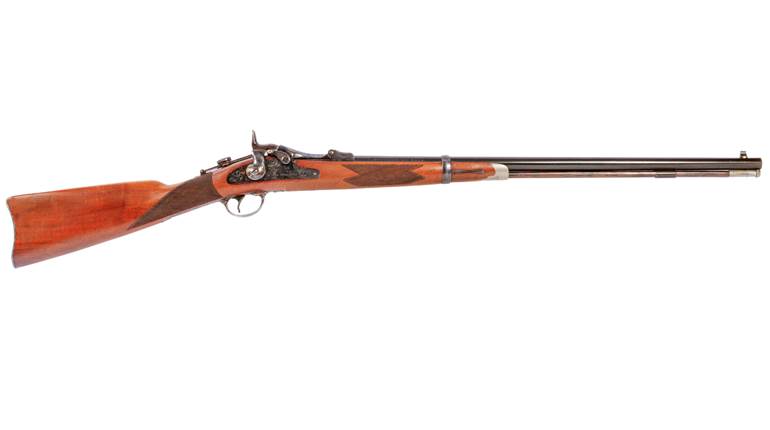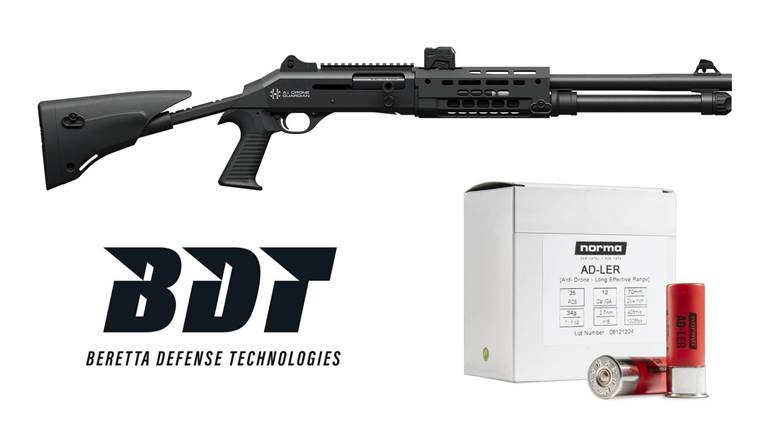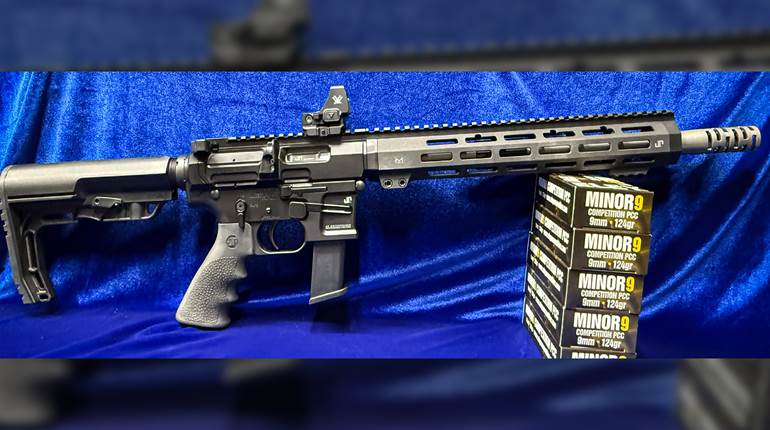
The firearm industry tends to move in waves, with many companies jumping onto something as it gains popularity. Earlier this year, the hype seemed to be all about lever-action rifles, so it was easy to miss that Taurus also broke new ground and set out to explore uncharted territory with a brand-new release for another hot segment of the American market: the bolt-action “practical rifle.” Dubbed the Expedition, it is one more entry into the niche of rifles that use full-power centerfire cartridges such as .308 Win. or 6.5 mm Creedmoor in a rugged, easy-to-carry format. You might think of it as a modern update to Jeff Cooper’s Scout Rifle concept.
Taurus has roots going back to 1924 as a tool and die manufacturer. Known as Forjas Taurus, Portuguese for “Taurus Forge,” its first revolver came to market in 1941—the Model 38101SO. After several years of focusing on revolvers, and changing ownership a few times along the way, the company hit a major milestone in 1980. Beretta had just completed a contract for producing the Model 92 for the Brazilian government. The contract stipulated that the pistols come from a Brazilian factory using Brazilian labor. Afterward, Beretta sought a buyer for the factory—and Forjas Taurus stepped up to purchase all the drawings, tooling, machinery and an experienced workforce. That resulted in the Taurus PT92, which holds a fond place in my heart as the first pistol I ever shot as a teenager many years ago.
In 1982, Taurus formed American-based Taurus Holdings, Inc. in Miami, Fla. This led to Taurus Intl. Mfg. and opened up the vast American market. Forjas Taurus also re-named itself to Taurus Armas to reflect its growing focus on the small arms market. It is the largest firearm manufacturer in South America, with many contracts across a variety of platforms, including semi-automatic rifles and submachine guns for the South American market. In fact, the Taurus T4, the company’s version of the AR-15 platform, enjoyed a short stint on the U.S. market as well. Up to this point, American shooters primarily have experience with Taurus’ pistols and revolvers. Its entry into the bolt-action market may seem like a surprise. So what does a pistol and revolver company know about rifles? As it turns out, quite a bit.
To get the history of the Expedition rifle in particular, I spoke to Caleb Giddings—Taurus USA’s general manager of marketing. Giddings relayed that after developing the machining and quality control needed for the well-received Executive Grade line of revolvers, Taurus wanted to turn its sights on to something new and unexpected. The answer came from Taurus Holdings’ President and Chief Executive Officer Bret Vorhees, who also happens to be an avid hunter. He envisioned a rifle that was affordable yet still something you’d be proud to carry.
The Taurus Expedition is the result, a “do-all” rifle designed to work equally well for hunting as it does ringing steel, riding in a truck for “just-in-case” purposes or taking care of predators on a ranch.
Out Of The Box
When you’ve handled enough rifles at different price points, you develop expectations on what you’ll see. On the budget-friendly end of the spectrum, that usually means thin plastic stocks, rough finishes or a lack of little quality-of-life features you find on more expensive options; the rifle may still shoot accurately, but it usually lacks refinement. In the long run, such rifles usually get upgrades such as aftermarket stocks or chassis systems that add several hundred dollars more to the original price. I’m happy to say that this was not my impression of the Expedition rifle, which comes in at an MSRP of $985. At first glance, it appears that Taurus did its homework and surveyed what the bolt-gun market likes. The company found a way to engineer those features into a single platform and keep the price below $1,000.
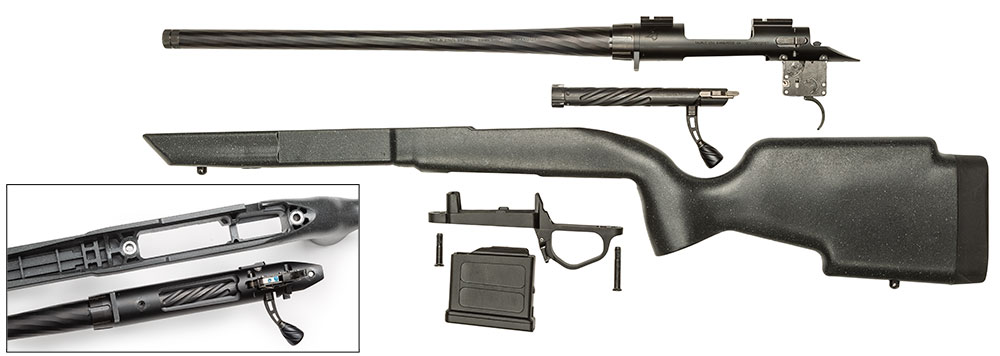
Generally following the Model 700 pattern means that the Expedition should be compatible with most aftermarket barrels, stocks, triggers, scope bases and bottom metal made for the popular Remington design. The Taurus’ action screws are both pillar-bedded (inset), a nice touch on a budget-friendly rifle.
The first thing I noticed upon taking the rifle out of the case was the meaty, speckled-gray synthetic stock. While still polymer, it feels tougher and less “plasticky” than other options on the market I’ve handled around this price point. The rear stock features a non-adjustable, raised cheekpiece. At the very back is a fixed 1"-thick foam pad. The bottom of the buttstock features a gentle hook for the hand to hold as well as a slope ideal for riding bags. There’s also a single sling swivel point. The length of pull is a hair more than 14". The fore-end has a slim 1.55"-wide profile, suited to the field-rifle pedigree. The sides have a scalloped design for nestling into a tripod saddle. Along the flat bottom of the fore-end you’ll find a standard sling swivel point, two M-Lok segments and a quick-detach socket purpose-built for the popular Spartan Precision mounting system. Handling the rifle in bare form, the Expedition weighed in at 6 lbs., 11 ozs., with the balance point at the front of the AICS-pattern magazine well. This is about perfect for me and provides a lively feel for assuming field shooting positions.
The 18" stainless-steel barrel has a straight taper profile, which I measured at 0.74" diameter behind the knurled thread protector. This puts it in the medium-weight, “light target” category of usage; not as light as a pure hunting barrel, but not as heavy as a match barrel, either. Another interesting feature of the barrel is the spiral-shaped fluting. Except it’s not actually fluting at all. Typical fluting is the process of removing barrel material in a way that lightens the barrel while attempting to keep the stiffness of a thicker barrel. In the Expedition’s case, there doesn’t appear to be anything actually removed. I asked Giddings about this, and the answer is that this spiral pattern is a consequence of the hammer-forging process used to craft the rifle’s barrel.
If you aren’t familiar with it, hammer forging is one of a few ways to create the rifling. Traditional methods like cut or button rifling use tooling to remove material from the bore and leave behind the desired rifle pattern. Hammer forging takes a different approach. Machinists insert a mandrel with a negative image of the desired rifling into the bore of a short and fat “blank.” This blank goes into the hammer-forging machine, which beats the barrel into shape from all directions with 50 tons of force. The impacts compress the barrel steel around the mandrel and form a uniform bore and rifling pattern. One of the byproducts of hammer forging is that the completed barrel comes out the other end with a unique spiral pattern around it from where the hammers made their impacts. Most barrel manufacturers polish these ridges off to bring the barrel back to a smooth, round cylindrical shape. In this case, Taurus left them in place to add a bit of character. “Because it looks cool” is as good a reason as any.
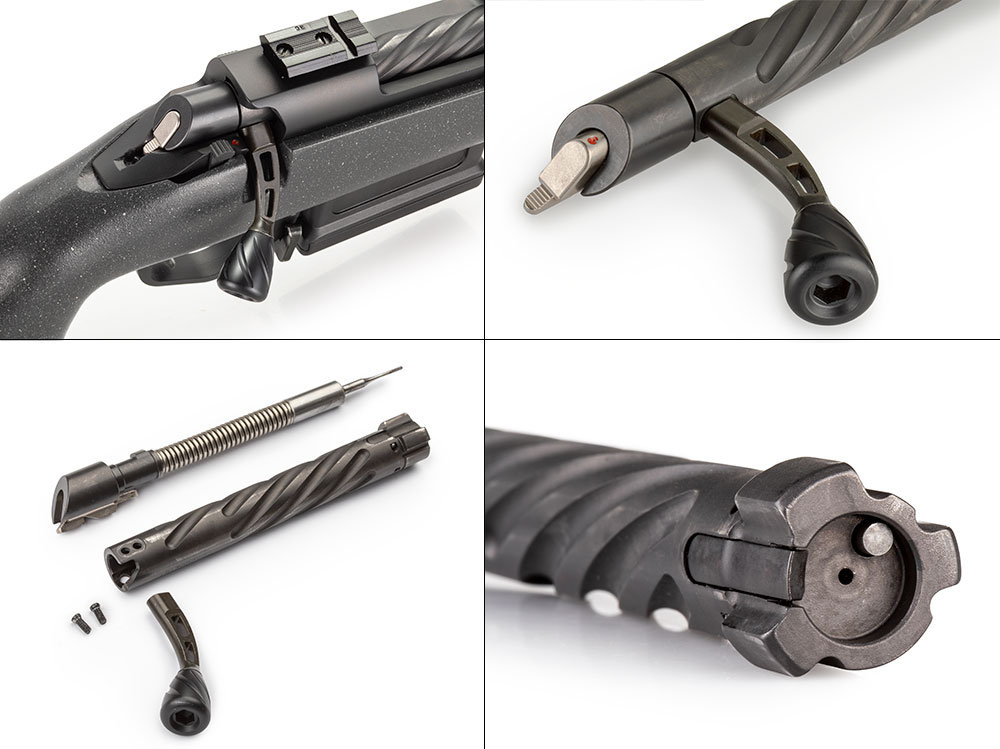
The Expedition’s two-position safety slides forward to fire (top l.). A red dot signals when the bolt is cocked (top r.), and an Allen key can be used to switch out the bolt knob to suit the shooter’s preference. (btm. l.) Lockup is by way of a three-lug bolt head that features an M16-style extractor and a plunger ejector (btm. r.). The bolt handle is attached to the body via a pair of screws.
The barrel mounts to the stainless-steel action via a barrel nut system that should facilitate replacing barrels and changing chamberings in the future. Another intelligent move on Taurus’ part was utilizing the tried-and-true Remington 700 footprint for the Expedition’s action. Because of that, the Expedition has access to the huge array of aftermarket support available to the Remington 700 platform, including stocks, pre-fit barrels, triggers, scope bases and bottom metal. While Taurus won’t guarantee it, if something fits on the Remington 700, then there’s a good chance it fits on the Expedition as well.
The three-lug bolt has a 70-degree throw, which I found to be smooth enough to not be distracting. For ejection, the Expedition utilizes an M16-style extractor paired with a single plunger ejector. The skeletonized metal handle is short, with a small teardrop knob threaded on. The bolt comes out of the action via a release button located on the left side of the rifle. Taurus treated the entire action and barrel with an attractive diamond-like carbon (DLC) coating to aid in durability. If you aren’t familiar, DLC has a flat, dark, gray graphite appearance to it. Also notable is that the action screws pass through two beefy metal pillars embedded within the stock. This aids with accuracy by reducing flex around the mounting points. Pillar bedding is not something you typically find on budget-friendly rifle stocks, so that was nice to see.
I tested the single-stage trigger with 10 pulls using a Wheeler digital trigger gauge, averaging 2 lbs., 14 ozs. In front of the trigger, you’ll find a metal paddle-style magazine release mounted to the polymer bottom metal. The magazine release pokes out to each side, enabling quick removal of the magazine with the trigger finger pushing forward. To finish things off for range testing, I mounted a Leupold Mark 4HD 2.5-10X 42 mm. This magnification range and scope size offers a nice balance of weight to capability, ideal for a “do-all” rifle format. I used Leupold 30 mm rings and a generic two-piece Remington 700 short-action scope base, which was actually the source of my only malfunction with the rifle during testing.

(l.) An ambidextrous, paddle-style magazine release is located at the front of the oversize trigger guard. Pressing forward on either side releases the AICS-pattern magazine from the action. (ctr.) Within the rifle’s fore-end there is a pair of M-Lok slots, a traditional sling swivel stud and a QD socket for a Spartan bipod. Scallops on each side of the fore-end are designed for use with a tripod saddle. (r.) The buttstock features a non-adjustable raised cheekpiece, a 1"-thick recoil pad and a sling swivel, along with a gentle hook for the support hand and a slope ideal for riding bags.
Testing The Expedition
I brought the Taurus Expedition out to Peacemaker National Training Center in Gerrardstown, W.Va. The Independence range features both 50-yard and 100-yard sighting points, as well as steel targets going out to 300 yards. This was a perfect testing environment.
 For initial sighting, I set the rifle up on a Caldwell Tack Driver front bag and plopped down on the bench behind it with a loaded 10-round AICS magazine. I pressed the bolt-release button and attempted to remove the bolt from the action and get a coarse bore sight. Unfortunately, the bolt wouldn’t come out. “Ok,” I thought, “No bore sighting today.” With a full magazine inserted, I ran the bolt to the rear then forward. To my surprise, it did not pick up a round. Moving forward with testing anyway, I single-fed each round into the chamber, and everything worked as far as firing and extraction. Not giving up, I inspected the raceway at the top of the action to see where the bolt was cycling. As it turns out, one of the screws from the two-piece mounting base was poking down into the action and obstructing the bolt from moving far enough to the rear to pick up fresh rounds.
For initial sighting, I set the rifle up on a Caldwell Tack Driver front bag and plopped down on the bench behind it with a loaded 10-round AICS magazine. I pressed the bolt-release button and attempted to remove the bolt from the action and get a coarse bore sight. Unfortunately, the bolt wouldn’t come out. “Ok,” I thought, “No bore sighting today.” With a full magazine inserted, I ran the bolt to the rear then forward. To my surprise, it did not pick up a round. Moving forward with testing anyway, I single-fed each round into the chamber, and everything worked as far as firing and extraction. Not giving up, I inspected the raceway at the top of the action to see where the bolt was cycling. As it turns out, one of the screws from the two-piece mounting base was poking down into the action and obstructing the bolt from moving far enough to the rear to pick up fresh rounds.
This was a quick fix with a few tools and a torque limiter I keep in my range bag. The rearmost screw was the culprit, as it was slightly longer than the rest. After moving it to the front base and out of the way of the bolt, the rifle cycled ammunition without issue. This situation isn’t a knock against the Taurus Expedition, but more of a cautionary tale for shooters who might not think to check such things. The three-lug nature of the action means more material has to come out from under the top of the action to clear the raceway. If you’re accustomed to two-lug actions, you might never see this. The remainder of the test, consisting of about 200 rounds of ammunition, went off without a hitch.
I brought along three different loads of .308 Win. ammunition for this test: Hornady’s American Gunner 155-grain boattail hollow point (BTHP); Nosler’s 165-grain Ballistic Tip (BT); and Federal’s 150-grain Non-Typical Whitetail soft point. Velocity testing consisted of 10 shots from each load in front of a Garmin Xero C1 Pro chronograph. The most consistent performer of the day was Nosler, which produced an average speed of 2,654 f.p.s. and a standard deviation of 8 f.p.s. The Federal averaged 2,660 f.p.s., and the Hornady averaged 2,407 f.p.s. All three loads chronograph slower than their boxes indicate, an expected outcome with an 18" barrel, as ammunition manufacturers typically use a 24" test barrel for their box velocities. For accuracy, I mounted the Expedition into a Caldwell Hydrosled and fired a series of five, five-shot groups at 100 yards for each load. The top performer here was the Federal 150-grain Non-Typical, producing an average group size of 1.21" across 25 shots. The smallest group of the day went to the Hornady American Gunner, which produced a group only 0.80" in diameter. All three loads performed similarly, with average groups around 1.2".
With the basic testing out of the way, I moved the Expedition down to the steel plate range and set it atop a Vortex Radian tripod equipped with a Shadow Tech PIG Saddle. The saddle clamped into the recesses on each side of the stock forearm, and I went to work ringing steel at 200 and 300 yards. When that got boring, I took the rifle out of the saddle and shot from a variety of field positions including kneeling, squatting and sitting. Again, the rifle had no issue ringing steel at these distances to the limit of my own capability.
The Teardown
After the range session, I brought the rifle back home for a teardown and cleaning. This was uneventful, though I did notice that the skeletonized bolt handle loosened and developed a bit of slop during testing. Given this was a test sample, I don’t know how many shots this rifle has seen before it got into my hands. Fixing it took only a few minutes removing the bolt and striker assembly, then tightening two T-10 Torx screws affixing it to the bolt body. I don’t know if any threadlocker was used on this part, but, given the torque forces from cycling the bolt, I suspect it would be a good idea to add in the future. On one hand, I like that the bolt handle is replaceable—that means you could swap it out for something longer or more swept to enhance leverage during cycling. On the other hand, this is not a standard part for the Remington 700, which uses a different attachment method. Whether another style of bolt handle is ever available will depend on aftermarket support. Cleaning and inspecting the rifle was otherwise uneventful.
Closing Thoughts
So what exactly is the Taurus Expedition? In short, it’s a sub-$1,000 practical rifle conforming to the Remington 700 footprint. It includes all the bells and whistles that shooters past paid a lot of money to modify their rifles with and is not heavily dependent on proprietary components, with the entire ecosystem of bolt-action support for the Remington 700 being open to it. That’s not something easily said of other rifles at a similar price point.
To my knowledge, there aren’t any other rifles on the market doing exactly what this one does. The practical-rifle niche is a small one, and there are only a handful of competitors. I’ve spent time with many of them, both more expensive and less. I can comfortably say that the Taurus Expedition is well-positioned for success. It offers a nice balance of cost to performance while also being able to take advantage of a mind-boggling array of modifications for the tinkerers like me.












